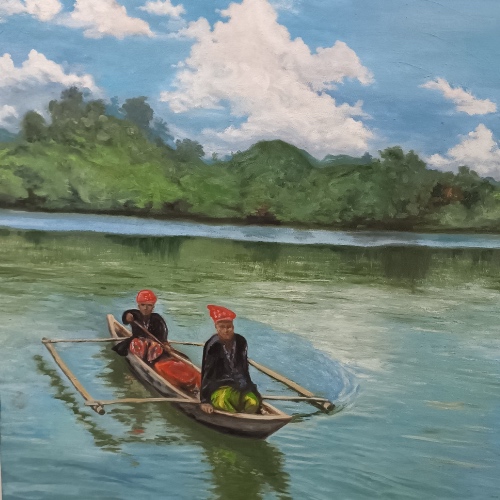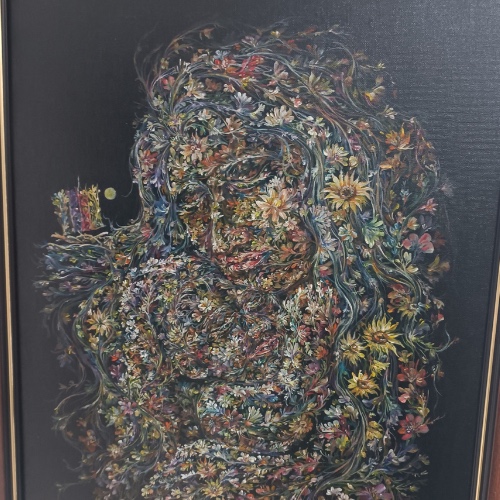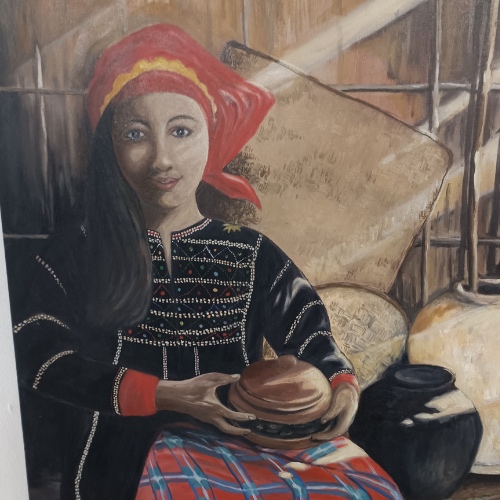Chavacano artists showcase works in Quezon City exhibit until July 29
In Quezon City, at the Erehwon Center for the Arts in Old Balara off Commonwealth Avenue, it is possible to see all the way to Zamboanga. This is so because until July 29, a group of Chavacano artists from the southern peninsula known for its indigenous tribes and delectable one-of-a-kind cuisine is staging an art show called "What Are You Made Of?” whose original working title was “The Greatest Show.”
The little I know of Zamboanga was gleaned from elementary school social studies textbooks that described it as a "city of flowers." On boat trips to the south where we got off in Dumaguete port, the ship would proceed to Mindanao, and passengers with their colorful tubao headdresses would drink rum on the open deck with the fragrant marang as sumsuman, all the while speaking in a strange dialect. Later, I got to read the essays and short stories of Cesar Ruiz Aquino, the poems of Francis Macansantos, and poems and stories of Anthony L. Tan that a clearer picture of the southernmost part of the country was formed, from Pagadian to Siasi, and every outrigger boat in between.
Isidro Floreta, now the unofficial elder statesman of Chavacano art since the passing of his mentor Willie Arseña years ago, leads a band of 16 artists for the show, including Florenbert Broñola, Romy Jones Mata, Christian Cueno, Jeremy Fabellano, Ramil Roscom Guerra, Joeff Jamalul, Abdel-aziz Masjiril, Elimar Pingkian, Juan Pedro Pollisco, Christianna Privado, Michelle Sing, Aileen Tan, Ingrid Valerie, Joefet Villegas, and Nelvert Anino. Paging please the Jumalons.

In an explanatory note sent on Messenger, Floreta writes: "Growing up as an adolescent in Mindanao: The Promised Land, now past middle-aged, I thought of something new."
"The group show’s exhibit title is 'Full of Airs,' 'mahangin,' one can say. True, in a way, because the participants, including yours truly, are quite unknown, the majority are upcoming, far from the proximity to the ‘gold standard’ of what is considered even great. We chose the title 'How an editor delivered a Marketing Strategy to Gabriel Garcia Marquez’s Hundred Years of Solitude' or how the heavyweight boxing champion Muhammad Ali proclaims to the world ‘I’m the Greatest.’ Also, an inspired one I knew and I guess you’re also familiar with Joseph the Dreamer from the Old Testament. Joseph, through his dream, telling him that he would be great someday, makes him favorite to his dad. But, sounds really ‘mahangin’ to his brothers."
“The Greatest Show may sound mahangin and can boomerang us back because only with (unconscious) humility can one be great: like Joseph, the Dreamer,” she says.

I first met Floreta around 30 years ago when he and Arseña had a two-man show at Madrigal Gallery in Ayala Alabang, and me and Cesar Ruiz took a high-speed car from Vito Cruz with Cesar clinging on to dear life on the front seat before the seat belt law was enacted. Arseña may not have been there but his masks and assorted work were, one of which eventually made its way to Siaton town in southern Negros at the time the mask-maker would make regular visits to his buddy Aquino in Dumaguete, after all, as adolescents they had given Zamboanga its first bohemia. Floreta was there with his work of Madonna and child portraits and vintas of varied shapes and sizes, if memory serves, with the scent of the indomitable sea.
At the low-key opening of What Are You Made Of?, Floreta mentions both Arseña and Aquino, how Arseña had picked up the art of making antiques from the national artist Abdulmari Imao, who had said all you have to do is submerge the prospective artwork in a batalan or well for days on end. Floreta said he noticed his mentor once washing a nearby boat paddle with soap and water, whenever taking a bath in an outdoor shower, to achieve the antique effect.

The cover design of Aquino’s novel Z for Short was of course by Floreta, a sort of reiteration of which is included in the present exhibit that runs for only a week at the Erehwon gallery annex, such that by the time you read this, all the paintings of the Subanon and Tausug, the houses on stilts and assorted boats on still water, the stardust in series and in a box and landscapes and scenery last seen in the pages of Camilo Osias’ Philippine Readers may have packed up and gone back too far off Zamboanga, or consigned to the bodega of the gallery in Old Balara until pullout.
The other artists, mostly from the Pinturas en Lienzos, were unable to make the opening due to various reasons, including a sudden spike in airfare with the so-called revenge tourism, but their works were there and it’s likely you’ll be hearing more from them, can’t stay unknown much longer.
Floreta himself will be taking the overland trip back to Zamboanga, and en route will be dropping by Dumaguete to pay a visit to Cesar Ruiz—no high-speed car for him, but the roll on, roll off with the marang and swig of rum for the wave, the art, the flower which is what we are made of.



